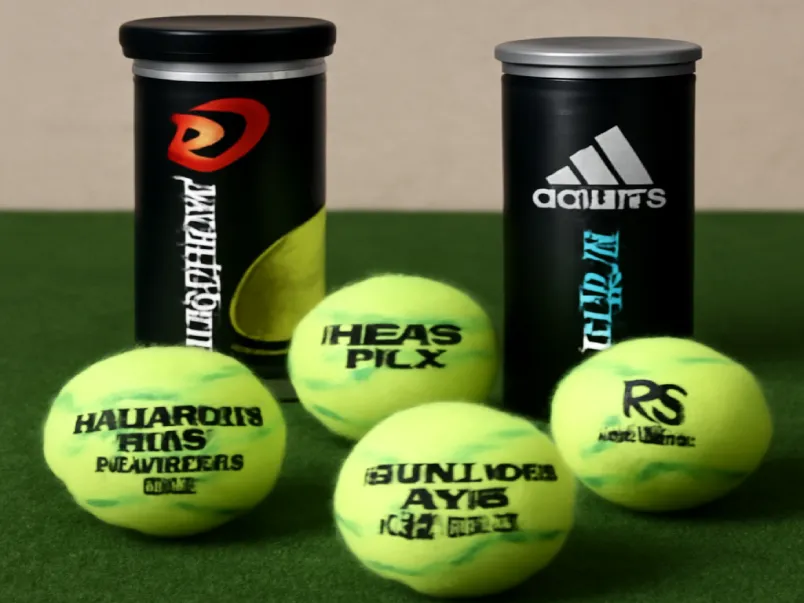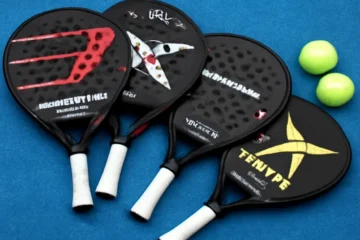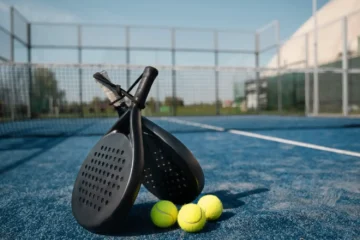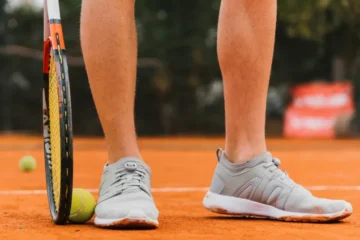Why the Right Ball Matters
Imagine you’re in the middle of an intense padel match. You make a perfect shot, but the ball sails way past your opponent. Or maybe the rally feels slower than usual, the ball bouncing unpredictably. Could it be your technique, or is there something else at play? Often, it’s the ball.
Choosing the right padel ball is more than a simple preference; it’s a game-changer. Whether you’re playing indoors or outdoors, the ball you choose can drastically affect your speed, control, and overall performance. The importance of selecting the right ball goes beyond aesthetics or brand name; it’s about matching the ball to the conditions you’re playing in. In this guide, we’ll walk you through the key differences between indoor and outdoor padel balls and help you pick the best ones for your game.
I. The Core Difference: It’s All About Pressure
When it comes to padel balls, the pressure inside the ball is the defining factor that determines its performance. While other variables like felt material, visibility, and durability play important roles, the internal pressure affects speed, bounce, and overall playability. Understanding the different pressure types will help you choose the right ball for your environment.
A. The Science Simplified: How Internal Pressure Affects Performance
Padel balls are designed with either high pressure or low pressure, affecting their bounce and speed. High-pressure balls are the standard choice for most players. These balls are designed for optimal performance at sea level, offering a lively bounce and a quick response. However, they are not the best for every scenario, as their fast bounce can be difficult to control in specific conditions. Low-pressure balls, on the other hand, have a slower bounce and are often used at higher altitudes or in specific weather conditions.
B. The Environmental Enemy: Altitude, Temperature, and Court Conditions
The environment you’re playing in can significantly impact how your ball performs. Let’s break it down:
- Altitude & Air Density: At higher altitudes, the air is thinner, which results in less resistance. This makes high-pressure balls act like rockets, leading to uncontrollable bounces. That’s why low-pressure balls are ideal for high-altitude areas, as they slow the ball down for better control.
- Temperature: Cold temperatures reduce the internal pressure of the ball, causing it to feel flat and sluggish. Conversely, in hot weather, the ball can become over-pressurized, making it bounce higher and move faster than usual.
- Humidity & Court Surface: While indoor conditions are more stable, outdoor courts are subject to a mix of wind, sun, and temperature fluctuations. These factors contribute to inconsistent ball behavior outdoors. A ball designed specifically for outdoor use can withstand these challenges better, giving you consistent performance.
II. Choosing Padel Balls for Outdoor Play
Outdoor padel play introduces a unique set of challenges. With varying weather conditions (wind, rain, humidity), plus the added abrasiveness of artificial grass or sand courts, outdoor balls need to be tough and durable. So, what should you look for when selecting outdoor balls?
A. The Challenge: Weather Variability and Court Surface Durability
Outdoor conditions are unpredictable. You could be playing in a breeze, under direct sunlight, or with varying humidity levels. These environmental factors demand a ball that can withstand not only the conditions but also the abrasion caused by outdoor court surfaces. Outdoor padel courts are typically made of artificial grass or sand, which can wear down a ball faster than indoor courts.
B. Key Characteristics to Look For:
- Durability: Outdoor balls need to have thicker felt to withstand abrasion from the rougher court surfaces. A more robust felt layer helps the ball last longer and maintain its performance throughout a match.
- Standard Pressure: A standard-pressure ball is optimal for play at or near sea level. It offers a good balance between speed and control, providing a consistent bounce for both offensive and defensive shots.
- Visibility: Outdoor play often involves direct sunlight or varying light conditions. Bright, vibrant balls (such as optic yellow or neon colors) are essential for visibility, allowing players to track the ball more easily.
C. Top Picks for Outdoor Padel:
- Bullpadel Hack Control CBT: This ball is known for its excellent durability and control, making it perfect for outdoor courts. The thicker felt layer resists wear from abrasive court surfaces, and its controlled bounce helps players execute precise shots.
- Head Padel Pro S: This ball is a favorite among professional players due to its consistent performance on outdoor surfaces. Its durability and ability to maintain consistent speed make it a top pick for outdoor matches.
- Dunlop ATP Padel Ball: Trusted by professionals worldwide, the Dunlop ATP Padel Ball offers high visibility and superb durability, making it ideal for outdoor play. Its performance in all weather conditions ensures a great game, no matter the environment.
III. Choosing Padel Balls for Indoor Play
When playing indoors, the lack of wind, temperature fluctuations, and other environmental factors create a more controlled game. Indoor padel balls are designed for consistent play in these conditions, and they need to focus on precision, control, and feel rather than durability.
A. The Challenge: Faster Game in a Controlled Environment
Indoor courts are typically made of wood, carpet, or synthetic surfaces that provide a more uniform bounce. Because there’s no wind or sun to affect the ball, the game tends to be faster and more predictable. As a result, indoor balls are designed to slow down the rally slightly, allowing for better control.
B. Key Characteristics to Look For:
- Softer Feel / Lower Bounce: Indoor balls are often designed with slightly lower pressure to give a softer feel and a lower bounce. This helps prevent the game from becoming too fast or uncontrollable.
- Durability: While indoor courts are less abrasive than outdoor ones, the ball still needs to be durable enough to withstand consistent play.
- Consistency: One of the primary advantages of indoor balls is their ability to maintain a consistent bounce and speed throughout the game. With no wind or weather-related variables, players can rely on the ball to behave predictably.
C. Top Picks for Indoor Padel:
- Adidas Speed RX Padel Balls: Known for their soft feel and controlled bounce, these balls are ideal for indoor play. They offer precision and consistent performance, making them perfect for fast-paced rallies in a controlled environment.
- Bullpadel Vertex WT: These balls are engineered with felt specifically designed for indoor courts, providing a smooth and consistent flight path. They’re perfect for players who want more control in their shots.
- RS Padel Balls: A premium option for indoor players, the RS Padel Balls are renowned for their consistency and feel. They maintain a soft yet durable performance, making them ideal for precision and control.
IV. The Special Case: High-Altitude Padel Balls
A. When to Use Them: Playing Above 500 Meters (1,500 Feet)
If you’re playing at a high-altitude location, the thinner air reduces air resistance, causing balls to travel faster than usual. This can make standard high-pressure balls unmanageable, as they may bounce too high and move too quickly.
B. How They Work: Low-Pressure Design for Better Control
To counteract the effect of thinner air, low-pressure balls are designed to slow down the ball’s speed and reduce its bounce. These balls offer more control, preventing the game from becoming too fast and difficult to manage at higher altitudes.
C. Top Pick Example: Head Padel Pro S Altitude
For players at high altitudes, the Head Padel Pro S Altitude ball is specifically designed to provide better control in regions above 500 meters. Its low-pressure core compensates for the thin air, offering a more predictable game.
V. Padel Ball Cheat Sheet & Quick Comparison Table
To help you quickly navigate the different types of padel balls, here’s a handy comparison table:
| Feature | Outdoor Balls | Indoor Balls | High-Altitude Balls |
|---|---|---|---|
| Pressure | Standard | Standard (feels softer) | Low |
| Felt Durability | Very High | High | Standard/High |
| Ideal For | Sea-level, windy conditions | Controlled, windless environments | Elevations above 500m |
| Player Feel | Durable, consistent bounce | Softer, more control | Slower, more controllable flight |
VI. Pro Tips for Maximizing Your Padel Balls
- Break Them In: New balls can feel hard and bouncy. Use them for a warm-up to get them ready for serious play.
- Check the Can’s Pressure: A “hiss” when you open a new can means the balls are properly pressurized and fresh.
- When to Replace: Look for loss of pressure (if the ball doesn’t bounce back to waist height) or visible wear on the felt.
- Storage: Store your balls in a cool, dry place away from sunlight to prevent premature degradation.
Conclusion: Serve Smarter, Not Just Harder
Selecting the right padel ball for your environment is essential for enhancing your game. By matching the right ball to the right court conditions, you’ll enjoy better control, increased consistency, and a more enjoyable game overall. Don’t let the wrong ball hold you back—make the smart choice for your environment and elevate your padel performance today!
FAQ: Choosing the Best Padel Balls for Indoor vs. Outdoor Play
1. What is the main difference between indoor and outdoor padel balls?
The main difference lies in the internal pressure and durability. Outdoor padel balls are designed with thicker felt to withstand rougher surfaces and environmental factors like wind and sun. Indoor balls are softer, with lower bounce and pressure, optimized for controlled environments without external variables.
2. Why do outdoor padel balls need thicker felt?
Outdoor padel balls face abrasive court surfaces like artificial grass and sand, which can wear down the ball quickly. Thicker felt helps improve durability and ensures the ball performs well even in harsh conditions.
3. Can I use indoor padel balls outdoors?
While you can technically use indoor padel balls outdoors, they are not recommended. They will wear out faster due to outdoor elements and won’t perform as well in variable weather conditions.
4. How do high-altitude padel balls differ from regular balls?
High-altitude padel balls are low-pressure balls that are designed to compensate for thinner air at higher elevations. They provide more control by reducing the speed and bounce that occurs due to reduced air resistance.
5. What is the ideal pressure for outdoor padel balls?
Outdoor padel balls typically have standard pressure, which works best for play at or near sea level. They provide a balance of speed and control, while still being durable enough for outdoor conditions.
6. How do I know when to replace my padel balls?
You should replace your padel balls when they lose pressure (they don’t bounce to waist height when dropped), when the felt shows visible wear, or if they develop cracks that affect their performance.
7. Can indoor balls be used for competitive matches?
Yes, indoor balls are designed for controlled environments and can be used in competitive indoor matches. They provide better precision and control, ideal for faster-paced rallies without the influence of wind or sun.




